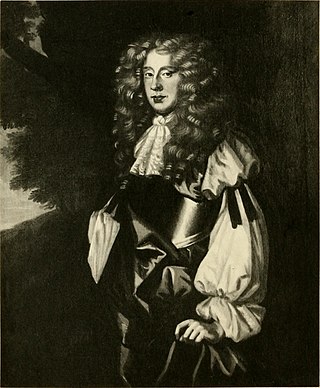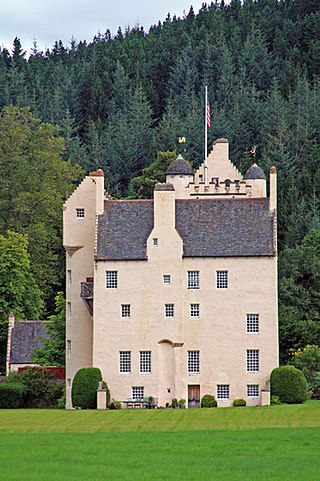Related Research Articles

Duke of Atholl, named for Atholl in Scotland, is a title in the Peerage of Scotland held by the head of Clan Murray. It was created by Queen Anne in 1703 for John Murray, 2nd Marquess of Atholl, with a special remainder to the heir male of his father, the 1st Marquess.

Lord Nairne is a title in the Peerage of Scotland, created by Charles II for Sir Robert Nairne of Strathord in 1681, which since 1995 is held by the Viscount Mersey.
Archibald Campbell, 4th Earl of Argyll or Archibald "the Red" Campbell, was a Scottish nobleman and politician.

Baron Keith was a title that was created three times in British history, with all three creations in favour of the same person, Admiral the Honourable Sir George Keith Elphinstone. He was the fifth son of Charles Elphinstone, 10th Lord Elphinstone by his wife Lady Clementine, daughter of John Fleming, 6th Earl of Wigtown and Lady Mary, daughter of William Keith, 8th Earl Marischal. The first creation came in the Peerage of Ireland in 1797 when he was made Baron Keith, of Stonehaven Marrischal, with remainder in default of issue male of his own to his daughter and only child from his first marriage, Margaret Mercer Elphinstone, and the heirs male of her body. On 15 December 1801 he was created Baron Keith, of Stonehaven Marischal in the County of Kincardine, in the Peerage of the United Kingdom, with normal remainder to heirs male. In 1803 he was made Baron Keith, of Banheath in the County of Dumbarton, in the Peerage of the United Kingdom, with remainder to his daughter and only child from his first marriage, Margaret Mercer Elphinstone and the heirs male of her body. In 1814 Lord Keith was further honoured when he was made Viscount Keith in the Peerage of the United Kingdom, with normal remainder to heirs male.
George John Charles Mercer Nairne Petty-Fitzmaurice, 8th Marquess of Lansdowne, DL, was a British peer and Conservative politician.

John Murray, 1st Marquess of Atholl, KT was a leading Scottish royalist and defender of the Stuarts during the English Civil War of the 1640s, until after the rise to power of William and Mary in 1689. He succeeded as 2nd Earl of Atholl on his father's demise in June 1642 and as 3rd Earl of Tullibardine after the death of his first cousin the 2nd Earl in 1670.

William Drummond, 4th Viscount Strathallan was a Scottish peer and Jacobite, who died at the Battle of Culloden.
John St Clair, Master of Sinclair was a Scottish Army officer and Tory politician who sat briefly in the British House of Commons in 1708 before he was excluded as ineligible as eldest son of a Scottish peer. He was court-martialled and under sentence of death for the killing of two fellow officers before he escaped to serve in the Prussian army and was subsequently pardoned. He then took part as a rebel in the Jacobite Rebellion of 1715 and was attainted and excluded in succession to his father's property. He returned to Scotland after ten years abroad.

Sir William Borthwick, 3rd of Borthwick and later 1st Lord Borthwick was a Scottish peer and ambassador.
General Robert Cuninghame, 1st Baron Rossmore, PC (Ire) was an Irish British Army officer and politician.
James Colville, 1st Lord Colville of Culross (1551–1629) was a Scottish soldier, courtier, and diplomat.
William Douglas, 1st Marquess of Douglas and 11th Earl of Angus (1589–1660) was a Scottish nobleman.

Charles Gordon, 4th Earl of Aboyne. The eldest son of John Gordon, 3rd Earl of Aboyne and Grace Lockhart, he succeeded his father as 4th Earl of Aboyne on 7 April 1732. On his death in 1794 he was succeeded in his titles by his eldest son.
Dermod McMurrough O'Brien, 5th Baron Inchiquin was an Irish baron.
Sir James Fergusson of Kilkerran, 2nd Baronet, Lord Kilkerran (1688–1759) was a Scottish judge.
Colonel Archibald Macneil 5th laird of Colonsay, was a Scottish laird who served as an officer in the British Army during the Napoleonic Wars.
Margaret Mercer Elphinstone, comtesse de Flahaut, Baroness Keith and Nairne, was a Scottish society hostess.
William Murray, 2nd Lord Nairne was a Scottish peer and Jacobite who fought in the Rising of 1715, after which he was attainted and condemned to death for treason, but in 1717 he was indemnified and released.
William Douglas, 1st Earl of Queensberry was a Scottish noble.
James Douglas, 2nd Earl of Queensberry was a Scottish noble, politician and Covenanter.
References
- Lundy, Darryl (28 September 2008), "General William Robertson of Lude", Person Page, p. 31120 § 311195 The Peerage
- Mosley, Charles, ed. (2003), Burke's Peerage, Baronetage & Knightage, vol. 2 (107th in 3 volumes ed.), Wilmington, Delaware, U.S.A.: Burke's Peerage (Genealogical Books), p. 1726
- Attribution
 This article incorporates text from this source, which is in the public domain :Anderson, William (1867), "Robertson", The Scottish Nation, Or the Surnames, Families, Literature, Honours and Biographical History of The People of Scotland, vol. III, Edinburgh: A Fullarton & company, pp. 383–384
This article incorporates text from this source, which is in the public domain :Anderson, William (1867), "Robertson", The Scottish Nation, Or the Surnames, Families, Literature, Honours and Biographical History of The People of Scotland, vol. III, Edinburgh: A Fullarton & company, pp. 383–384